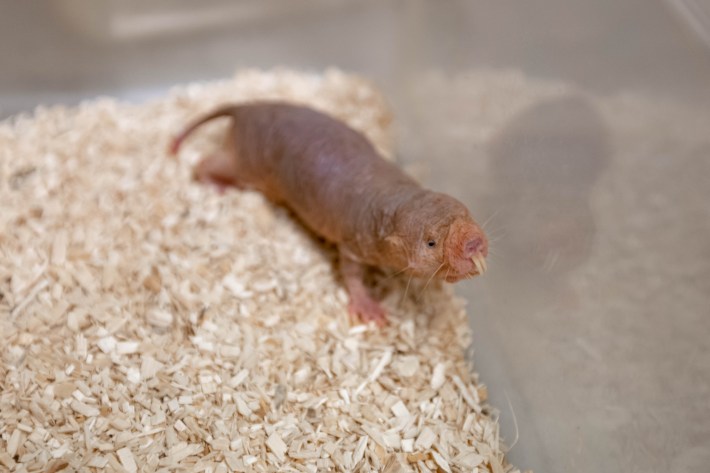Even though Miguel Brieño-Enriquez had only known Camila for a few months, he wanted to be in the room when she gave birth. The female naked mole-rat had arrived in his lab at the University of Pittsburgh School of Medicine in May 2020. One September morning, Brieño-Enriquez, who is a reproductive aging scientist, noticed she was bending strangely, as if doing crunches. Around noon, he got a call that Camila's vagina was dilated. He rushed to the lab to witness the miracle of naked mole-rat birth: a pink pup, about the size and color of a strawberry daiquiri jellybean.
"You know when you see the videos of dads seeing when the baby is born?" Brieño-Enriquez said. "I was so excited to see it that I was like, come on! Come on!" he added. After about 30 minutes of labor produced a second pup, Brieño-Enriquez gave the naked mole-rat some privacy. By the next morning, Camila was a mother of eight.
Camila, who is now three years old, will continue having pups for the rest of her exceptionally long life. Although mammals of her size would be expected to live only six years, naked mole-rats can live as long as 37 years. And unlike other mammals, Camila's fertility will never falter with age; there is no mole-rat menopause in her future.

Brieño-Enriquez and colleagues investigate how Camila and other female naked mole-rats achieve their seemingly eternal fertility in a paper published Tuesday in Nature Communications. Most mammals are thought to be born with a finite number of egg cells that diminish over time. The authors found that female naked mole-rats are born with an astronomical number of egg cells for their small body size, and less of these cells appear to die over time. But, most remarkably, they found the rodents continued to create new egg cells long after they were born—continuing their species' trend of breaking every rule known to mammal-kind.
Research over the last 20 years has suggested that ovaries may be able to produce new eggs throughout the mammal's life—a concept called postnatal oogenesis that challenged longstanding ideas about the ovary that had been dogma for decades.
"We think of human ovarian depletion as an unsolvable problem, as a biological certainty, but this weird mammal just showed us that it is completely conceivable that ovary stem cells do exist and can be activated any time," Kaitlyn Webster, a reproductive biologist at Harvard Medical School who was not involved with the research, wrote in an email that also included the word "egg-citing."
When Ned Place, a professor at Cornell University College of Veterinary Medicine in Ithaca and an author on the paper, read that naked mole-rats continue to produce offspring into their third decade of life, he wondered: If any mammal might be capable of producing new, functional eggs throughout their lifetime, the naked mole-rat would be an excellent candidate.
Place emailed some naked mole-rat researchers to see if they had any ovaries to spare. Melissa Holmes, a behavioral neuroscientist at the University of Toronto and an author on the paper, shipped a potpourri of fixed and frozen ovaries from young adult mole-rats to Ithaca. "I was just initially blown away by how many eggs they had," Place said. He was even more surprised that ovaries from five-day-old naked mole-rats hadn't formed any follicles at all—egg cells surrounded by support cells—which are abundant in a mouse of the same age.

At the time, Brieño-Enriquez was a postdoctoral researcher at Cornell and had no idea what a naked mole-rat was. But he volunteered to take a closer look at fresh ovarian samples from a five-day-old mole-rat that Holmes sent Place. When he stained the cells, he found what appeared to be primordial germ cells—the undifferentiated cells that divide and differentiate to form eggs inside ovarian follicles. "This is kind of crazy, because they should not be here at this time," Brieño-Enriquez said.
The researchers analyzed ovaries from naked mole-rats that were 1, 5, 8, 15, 28, and 90 days old. They found the eight-day-old naked mole-rat had about 1.5 million germ cells, an increase from younger ovaries that suggested the cells had been dividing after birth. And the three-month-old mole-rat ovaries had germ cells alongside mature follicles. "That is basically a violation of what we'd think of as a natural gonad law for mammals," Webster said, noting that vertebrates like fish can repeatedly produce enormous amounts of eggs for a long time. "It changes how we think about reproductive aging and of what the ovary is capable," Holmes said.
Brieño-Enriquez performed most of the experiments in his own lab in Pittsburgh, with a colony of his own. Like ants and bees, naked mole-rats are eusocial creatures. They live in colonies of up to 300 where only one female—the queen—is capable of breeding. Although the queen's presence prevents other females from reproducing, the subordinate females can become reproductively active if removed from the colony and placed with a male. "Every girl can be a queen," Brieño-Enriquez said.
After cold-emailing some researchers, Brieño-Enriquez obtained 20 female naked mole-rats and 20 males. He separated them to remove all traces of everyone's scent; if female naked mole-rats smell another female on a male, "they will kill him," he said. About two months later, it was time to pair the rodents off and make the girls all queens. But female naked mole-rats do not always take kindly to blind dates. "The girls are feisty," Brieño-Enriquez said. "If they don't like the male, they go for the neck."
It took time to shuffle around the pairings until all would-be-queens—who Brieño-Enriquez had named after supermodels and other iconic figures such as the fertility goddess Xochiquetzal and Regina George—were satisfied. Naomi did not like the first male presented to her, or the second. Donatella was also tricky to pair.

The subordinate females do not have names; there are simply too many of them. But in Webster's eyes, the authors' observations on the subordinate females was "the sleeper hit of this paper," she said. "Somewhere in here is a great metaphor for the valid choice to remain child-free," Webster said. "Why would they waste their biological resources creating follicles when they could refocus that energy elsewhere?"
The new paper shows how fruitful it can be to study weird creatures like naked mole-rats, Webster added. Beyond their infamous appearance, naked mole-rats rarely get cancer, are impervious to some kinds of pain, and can survive without oxygen for 18 minutes. They produce no body heat and drink no water. Colonies chirp to each other in distinct dialects inherited from their queen. They are, quite literally, built different.
Meanwhile in Pittsburgh, Brieño-Enriquez's queens are thriving. Last week, Sabrina bore eight pups, Aphrodite had 10, and Venus had 12. "We are happy parents of 30-something more," he said. They are eating well. "Each day they eat something different," Brieño-Enriquez said. "One day it is sweet potatoes and celery. Another day it's grapes and carrots." He also likes to watch them run around their cages. Naked mole-rats can run in both directions, forwards and backwards, at the same speed. "Those girls are fast. Zoom! Zoom!" he said.
Brieño-Enriquez knows the remarkable lifespans of his wrinkly wards means his queens may still be in the prime of their lives when he retires. "I do not have kids. But these are my babies," he said. "So sooner or later, my babies will be the babies of someone else." Sometimes, when Brieño-Enriquez ponders the sharp turn his life has taken toward naked mole-rats, he remembers how little he knew about them and the serendipitous email from Place that started it all. "Definitely, they found me," he said. "They changed my life."






